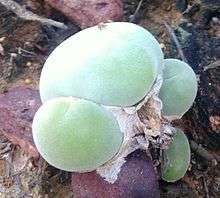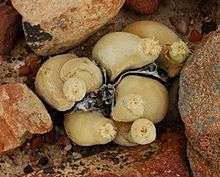Muiria
Muiria hortenseae ("mouse-head") is a rare dwarf species of succulent plant of the family Aizoaceae, indigenous to a very small area in the Little Karoo, Western Cape, South Africa. It is the only species in the monophyletic genus Muiria.
| Muiria | |
|---|---|
 | |
| Scientific classification | |
| Kingdom: | |
| (unranked): | |
| (unranked): | |
| (unranked): | Core eudicots |
| Order: | |
| Family: | |
| Genus: | Muiria N.E.Br. |
| Species: | M. hortenseae |
| Binomial name | |
| Muiria hortenseae N.E.Br. | |
Description

Unlike most other plants in its family, Muiria is covered in soft downy fur (from which it gets its common name) and has leaves that are entirely fused together, into one smooth rounded body.
In the summer it produces white or pink flowers, that tear through the (still living) flesh of the plant. The flesh then withers into a papery sheath, within which the new body forms. After several generations of subdivisions, it can form clumps.[1]
Life-cycle
Like many related plants, Muirias grow in annual cycles of growth and dormancy.
Their habitat is a winter rainfall region. They therefore begin their growth cycle in early autumn when the first rains arrive, pushing out of the dry sheaths which remain from the previous years dead leaves, and forming the new green growth. Throughout the winter, they receive mists and occasional rainfall. By the end of winter, the new growth stops and appears to decay, becoming more yellow and soft in the spring. The flower buds can then push through the softened flesh.
With the onset of the full summer drought, flowering ends, the old flesh gradually dries into a papery sheath and the plants enter a brief dormancy (which can last any period between a few weeks and four months). The first new rains bring it out of dormancy and commence the cycle again.
Distribution and habitat
Muiria is indigenous to a tiny arid area (c.300 mm annual rainfall) of the "Succulent Karoo" in the Western Cape, South Africa. Its habitat is the quartzite rubble that overlay clay soils on the low ridges near the Langeberg Mountains.
In this extremely small range, it has recently suffered an enormous reduction in population and range, due to habitat loss, trampling by stock animals and illegal collecting.[2]
Cultivation
Muiria hortenseae is difficult to cultivate, as it requires sparing but steady watering throughout most of the year, generous space for its large root system, and a rocky, gritty, extremely well-drained soil. Some cultivators also occasionally add a one or two grains of salt to the soil surface, to add an extremely slight salinity to the soil. It is also recommended to give it little to no water for a drought of a month or two, after it has flowered.
Propagation is usually by seed, and Muiria sometimes hybridises with Gibbaeum album, with which it shares its natural habitat in the Little Karoo.[3]
References
- "Muiria On-line Guide to the positive identification of Succulent Plant Families". succulentguide.com. Retrieved 2014-07-31.
- "Threatened Species Programme | SANBI Red List of South African Plants". redlist.sanbi.org. Retrieved 2014-07-31.
- "The New Mastering the Art of Growing Mesembs by Steven Hammer". files.nyu.edu. Archived from the original on 2014-08-11. Retrieved 2014-07-31.
External links
| Wikispecies has information related to Muiria |
| Wikimedia Commons has media related to Muiria. |